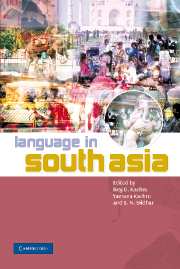Book contents
- Frontmatter
- Contents
- List of Figures
- List of Maps
- List of Tables
- Preface
- Acknowledgments
- List of Abbreviations
- Note on Transcription
- Introduction: languages, contexts, and constructs
- Part 1 Language history, families, and typology
- Part 2 Languages and their functions
- Part 3 Sanskrit and traditions of language study
- 8 Sanskrit in the South Asian sociolinguistic context
- 9 Traditions of language study in South Asia
- Part 4 Multilingualism, contact, and convergence
- Part 5 Orality, literacy, and writing systems
- Part 6 Language conflicts
- Part 7 Language and modernization
- Part 8 Language and discourse
- Part 9 Language and identity
- Part 10 Languages in diaspora
- References
- Subject Index
- Language Index
- Author Index
8 - Sanskrit in the South Asian sociolinguistic context
Published online by Cambridge University Press: 04 May 2010
- Frontmatter
- Contents
- List of Figures
- List of Maps
- List of Tables
- Preface
- Acknowledgments
- List of Abbreviations
- Note on Transcription
- Introduction: languages, contexts, and constructs
- Part 1 Language history, families, and typology
- Part 2 Languages and their functions
- Part 3 Sanskrit and traditions of language study
- 8 Sanskrit in the South Asian sociolinguistic context
- 9 Traditions of language study in South Asia
- Part 4 Multilingualism, contact, and convergence
- Part 5 Orality, literacy, and writing systems
- Part 6 Language conflicts
- Part 7 Language and modernization
- Part 8 Language and discourse
- Part 9 Language and identity
- Part 10 Languages in diaspora
- References
- Subject Index
- Language Index
- Author Index
Summary
Introduction
Sanskrit as a language has had a life span of more than thirty-five hundred years. Like the proverbial nine lives of a cat, Sanskrit has survived in changing circumstances, some of which we do not yet fully understand. Its manifestations range from its near-mother-tongue usage to its ritualized, technical, narrative, and poetic forms. Its changing geography extends from its original home in the northwestern corner of the Indian subcontinent to its use as a language of high social, literary, and political culture to a region extending from Central Asia to Cambodia and Vietnam, but most importantly surviving as the classical language of the Indian subcontinent. There must have been a time when a form of Sanskrit was a mother tongue of some Indo-Aryan group, and yet with all the sources available to us, we are today unable to recover that stage of Sanskrit. What we have is mostly a picture of Sanskrit embedded in a social context where it is a language of high prestige, but a language that must coexist and compete with other Indo-Aryan and non-Indo-Aryan languages. The sociolinguistic context of Sanskrit must be recovered from this massive literary, geographical, and social environment.
M. B. Emeneau remarks (Deshpande 1979b, foreword, 1):
In the earliest period speakers of Indo-Aryan – Vedic and living Sanskrit – were concerned with neighboring languages, whether they were other varieties of Indo-Aryan or were non-Indo-Aryan; the historical dimension had hardly yet come into play. Thereafter, when Sanskrit was no longer a living language but was a language of high prestige that had ceased to be anyone's first language, the concern was essentially an evaluation of various vernaculars as against the classical language.[…]
- Type
- Chapter
- Information
- Language in South Asia , pp. 177 - 188Publisher: Cambridge University PressPrint publication year: 2008
- 3
- Cited by



